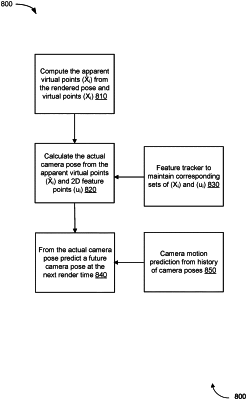| CPC G06T 7/248 (2017.01) [G06T 7/74 (2017.01); G06T 13/20 (2013.01); G06T 15/20 (2013.01); G06T 19/006 (2013.01); H04N 5/2224 (2013.01); G06T 2207/30244 (2013.01); H04N 5/275 (2013.01)] | 20 Claims |

|
1. A method for implementing camera tracking in a virtual production environment, the method comprising performing, by a computer system communicably coupled with a physical camera that is movable:
identifying a first position of the physical camera corresponding to a first time period;
rendering, using an animation engine, a first virtual scene for the first time period;
projecting the first virtual scene onto a display surface to determine a first rendered image for the first time period, the projecting of the first virtual scene consistent with the first position of the physical camera;
storing the first rendered image in a frame buffer for displaying on the display surface;
receiving a first camera image of the display surface, the first camera image obtained using the physical camera during the first time period;
determining a first corrected position of the physical camera by comparing the first rendered image to the first camera image;
predicting, using the first corrected position, a second position of the physical camera corresponding to a second time period in which a second rendered image is to be displayed on a display surface;
rendering, using the animation engine, a second virtual scene for the second time period; and
projecting the second virtual scene onto the display surface to determine a second rendered image for the second time period, the projecting of the second virtual scene consistent with the second position of the physical camera.
|